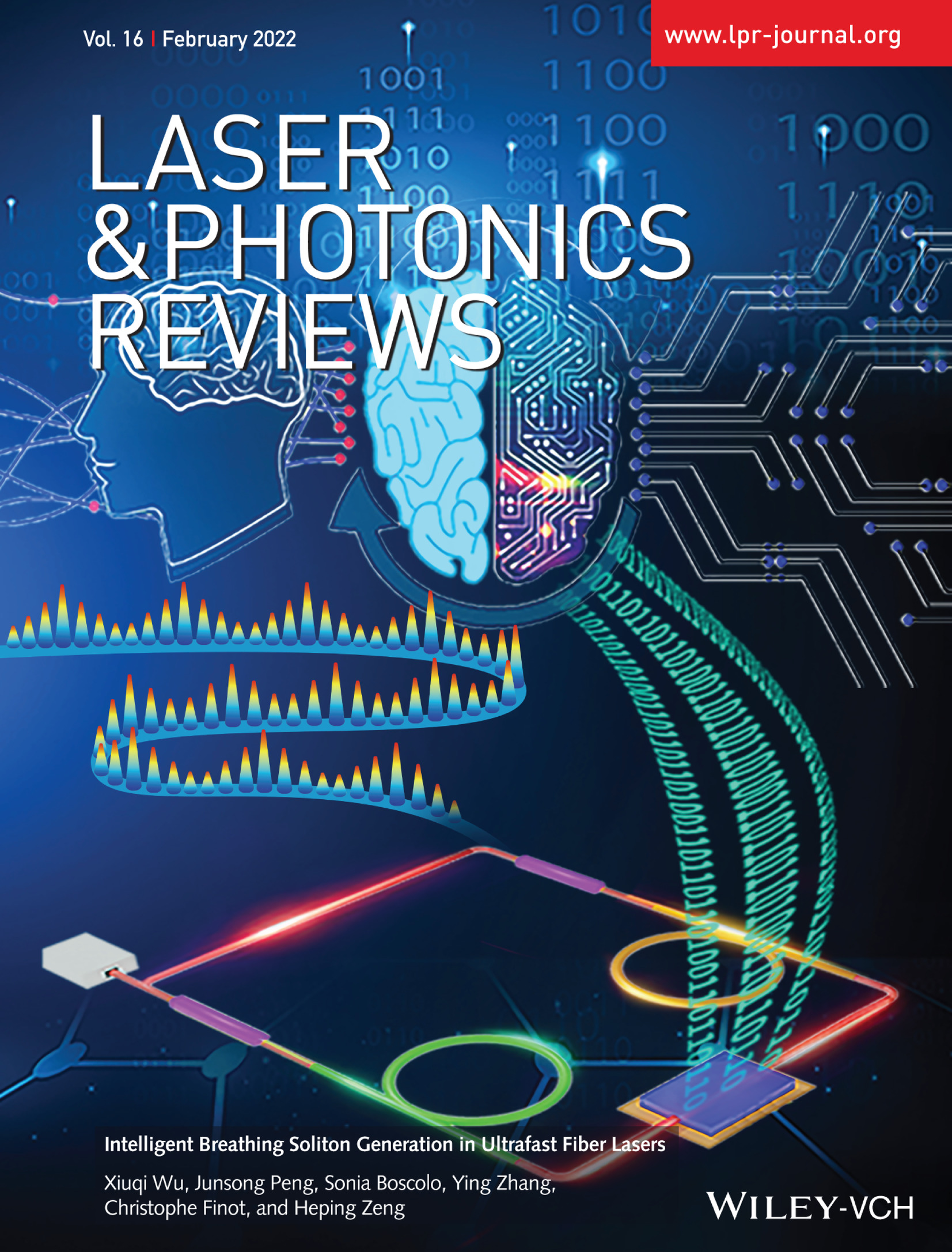Intelligent breathing soliton generation in ultrafast fiber lasers

If mode-locked lasers are in principle set like clocks and deliver identical ultrashort pulses at a perfectly determined rate, it is possible to excite other operations where the properties of the pulses vary slowly but in a cyclical manner: the laser breathes at a different rate than the pulse rate.

Access online :
- https://arxiv.org/abs/2108.09869 Xiuqi Wu, Junsong Peng, Sonia Boscolo, Ying Zhang, Christophe Finot, Heping Zeng, « Intelligent breathing soliton generation in ultrafast fiber lasers », Laser & Photonics Reviews , 16, 2100191 (2022)
- https://www.nature.com/articles/s41467-022-33525-0 Xiuqi Wu, Ying Zhang, Junsong Peng, Sonia Boscolo, Christophe Finot & Heping Zeng, “Farey tree and devil’s staircase of frequency-locked breathers in ultrafast lasers," Nature Communications 13, 5784 (2022)
Contact : christophe.finot@u-bourgogne.fr
This operating regime is one of many dynamics made possible by the complex combination of nonlinearity, dispersion, loss, and gain that exist in fiber optic lasers. To better understand these strange behaviors, a team of researchers bringing together the Normal University of East China (under the direction of Pr. Junsong Peng and Heping Zeng), the University of Aston (United Kingdom, Dr. Sonia Boscolo) and the laboratoire ICB (Pr. Christophe Finot) have imagined a laser capable of generating such structures and controlling their properties very finely thanks to advanced machine learning algorithms. Thus, drawing inspiration from the principles of Darwinism, the laser is able to adjust its parameters on its own in order to achieve, without human intervention, this operating regime which previously required laborious manual operations.
This “smart" laser developed allowed precise study of the interactions between the breathing rate of the pulses and the natural cadence of the laser. The experimental recordings then revealed the existence of a fractal structure, known as the devil's scale, which predicts areas of stable laser operation. This dynamic therefore owes nothing to chance and can be built according to a scheme called the Farey tree.
This understanding of the atypical functioning of this laser opens up new opportunities in the field of spectroscopy and in the production of optical frequency standards with very close spacing. This work has been the subject of the cover of the journal Laser Photonics Reviews as well as a publication in the prestigious scientific journal Nature Communications.
- kc_data:
- a:8:{i:0;s:0:"";s:4:"mode";s:2:"kc";s:3:"css";s:0:"";s:9:"max_width";s:0:"";s:7:"classes";s:0:"";s:9:"thumbnail";s:0:"";s:9:"collapsed";s:0:"";s:9:"optimized";s:0:"";}
- kc_raw_content:
- [kc_row use_container="yes" _id="518119"][kc_column width="12/12" video_mute="no" _id="387503"][kc_column_text _id="40335"]
If mode-locked lasers are in principle set like clocks and deliver identical ultrashort pulses at a perfectly determined rate, it is possible to excite other operations where the properties of the pulses vary slowly but in a cyclical manner: the laser breathes at a different rate than the pulse rate.
[/kc_column_text][kc_spacing height="30px" _id="358462"][/kc_column][/kc_row][kc_row use_container="yes" _id="88428"][kc_column width="45%" _id="805828"][kc_single_image image_size="full" _id="899570" image_source="media_library" image="36601"][kc_spacing height="20" _id="809353"][kc_column_text _id="985484"]Access online :
- https://arxiv.org/abs/2108.09869 Xiuqi Wu, Junsong Peng, Sonia Boscolo, Ying Zhang, Christophe Finot, Heping Zeng, « Intelligent breathing soliton generation in ultrafast fiber lasers », Laser & Photonics Reviews , 16, 2100191 (2022)
- https://www.nature.com/articles/s41467-022-33525-0 Xiuqi Wu, Ying Zhang, Junsong Peng, Sonia Boscolo, Christophe Finot & Heping Zeng, "Farey tree and devil’s staircase of frequency-locked breathers in ultrafast lasers," Nature Communications 13, 5784 (2022)
Contact : christophe.finot@u-bourgogne.fr
[/kc_column_text][/kc_column][kc_column width="5%" _id="205900"][/kc_column][kc_column width="50%" _id="250351"][kc_column_text _id="694678"]
This operating regime is one of many dynamics made possible by the complex combination of nonlinearity, dispersion, loss, and gain that exist in fiber optic lasers. To better understand these strange behaviors, a team of researchers bringing together the Normal University of East China (under the direction of Pr. Junsong Peng and Heping Zeng), the University of Aston (United Kingdom, Dr. Sonia Boscolo) and the laboratoire ICB (Pr. Christophe Finot) have imagined a laser capable of generating such structures and controlling their properties very finely thanks to advanced machine learning algorithms. Thus, drawing inspiration from the principles of Darwinism, the laser is able to adjust its parameters on its own in order to achieve, without human intervention, this operating regime which previously required laborious manual operations.
This "smart" laser developed allowed precise study of the interactions between the breathing rate of the pulses and the natural cadence of the laser. The experimental recordings then revealed the existence of a fractal structure, known as the devil's scale, which predicts areas of stable laser operation. This dynamic therefore owes nothing to chance and can be built according to a scheme called the Farey tree.
This understanding of the atypical functioning of this laser opens up new opportunities in the field of spectroscopy and in the production of optical frequency standards with very close spacing. This work has been the subject of the cover of the journal Laser Photonics Reviews as well as a publication in the prestigious scientific journal Nature Communications.
[/kc_column_text][/kc_column][/kc_row]
